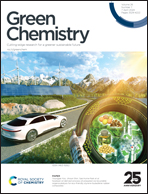Construction of biomass-based amines via Ir-mediated N-alkylation: kinetic analysis†
Abstract
Biomass-based secondary amine (5a) was obtained via N-alkylation of tetrahydrofurfurylamine (1a) with furfuryl alcohol (2a) using a heterogeneous catalyst composed of an Ir complex immobilized in covalent triazine frameworks. The mechanistic study suggested a borrowing-hydrogen route via three consecutive/reversible steps: dehydrogenation of 2a to provide furfural (3a), which is converted to imine (4a), and the subsequent hydrogenation of 4a by Ir hydride formed in the first step, finally yielding 5a. Kinetic analysis revealed a rate-determining step of 2a-to-3a dehydrogenation and the presence of reversible equilibrium in 4a-to-5a transfer hydrogenation. However, the additionally loaded hydrogen-source of HCOONa can completely shift N-alkylation to the 5a side by significantly reducing activation energy from 55.3 to 46.8 kJ mol−1 in the 4a-to-5a transfer-hydrogenation stage, which leads to a 15-fold increase in the rate constant for 4a hydrogenation at 140 °C. This research study highlights a kinetic understanding of N-alkylation for the construction of biomass-based amines.



 Please wait while we load your content...
Please wait while we load your content...